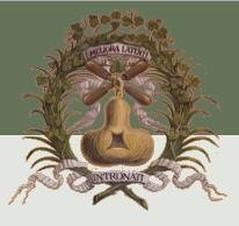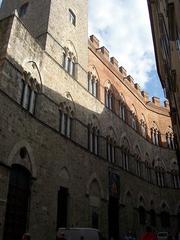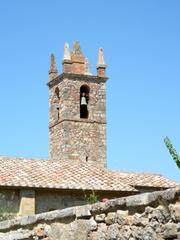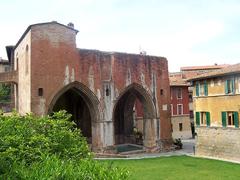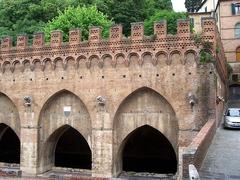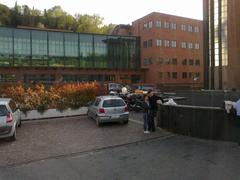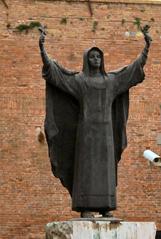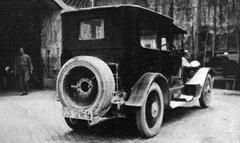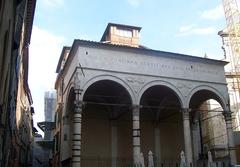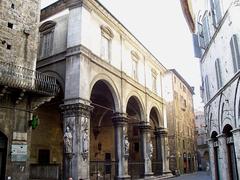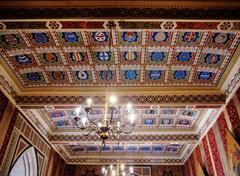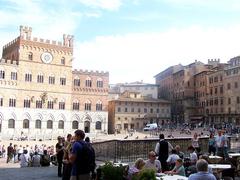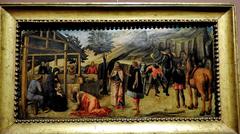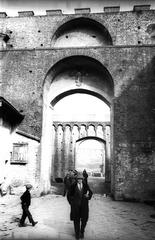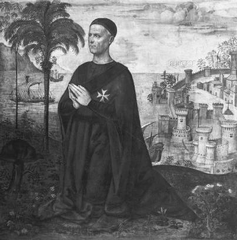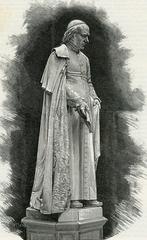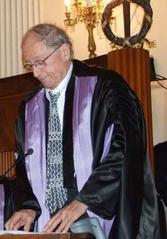Sant’Agostino Siena: Visiting Hours, Tickets & Historical Sites Guide
Date: 04/07/2025
Introduction
Sant’Agostino in Siena, Italy, is a remarkable monument of medieval devotion, Renaissance artistry, and later neoclassical refinement. Located in the historic heart of Siena, this church offers a layered journey through centuries of religious, cultural, and architectural history. Whether you are an art lover, history enthusiast, or traveler, this guide will provide all you need to know: from visiting hours and tickets to architectural highlights and insider tips for your visit.
Table of Contents
- Introduction
- Historical Overview: Origins and Construction (13th–15th Centuries)
- Architectural Evolution and Artistic Heritage
- The 1747 Fire and Neo-Classical Restoration
- 19th-Century Changes and Suppression of the Augustinians
- Sant’Agostino in Siena’s Religious and Artistic Landscape
- Practical Visitor Information
- Special Events and Guided Tours
- Nearby Attractions
- Best Times to Visit
- Frequently Asked Questions (FAQ)
- Practical Tips for Visitors
- Conclusion
- References
Historical Overview: Origins and Construction (13th–15th Centuries)
Founded in 1258 by the Augustinian order, Sant’Agostino’s construction spanned several decades into the late 13th century (Religiana). The church was conceived as part of a larger monastic complex on Prato di Sant’Agostino, a peaceful square within Siena’s medieval core. Unlike the more imposing churches of the Franciscans and Dominicans, Sant’Agostino’s original design reflects the Augustinian order’s emphasis on restraint and contemplation (Siena Guide PDF).
The 15th century saw significant expansion, notably the addition of chapels and the commissioning of important artworks. Local noble families, such as the Bichi and Piccolomini, played a crucial role in enriching the church’s artistic patrimony.
Architectural Evolution and Artistic Heritage
Exterior and Interior Features
- Façade: Sant’Agostino’s brick façade embodies Tuscan Gothic austerity, softened by the trees of Prato di Sant’Agostino. The neoclassical portico, designed by Agostino Fantastici in the early 19th century, provides an elegant, sheltered entry (it.wikipedia.org).
- Bell Tower: The robust, functional bell tower stands as a quiet city landmark.
- Interior: Inside, the church features a spacious nave with pointed arches, flanked by side aisles and chapels. The 18th-century redesign introduced colored marbles, stucco decorations, and a luminous, harmonious atmosphere (Religiana).
Major Artistic Highlights
- Bichi Chapel: Contains grisaille frescoes by Francesco di Giorgio Martini and ceiling paintings attributed to Luca Signorelli. The chapel’s rare 15th-century majolica floor tiles, though damaged, are a testament to its original splendor (Siena Guide PDF).
- Piccolomini Chapel: Home to the “Maestà” fresco by Ambrogio Lorenzetti and the “Adoration of the Magi” altarpiece by Sodoma.
- Altars and Sculptures: The church houses polychrome marble altars from the 16th and 17th centuries, stucco statues from Vanvitelli’s renovation, and unique works by Perugino, Carlo Maratta, Francesco Vanni, Rutilio Manetti, and other masters (sienafree.it).
The 1747 Fire and Neo-Classical Restoration
A devastating fire in 1747 led to a transformative restoration under Luigi Vanvitelli, who reimagined the church’s interior with Baroque and early Neoclassical elements. He introduced elegant stucco work, marble, and a reorganization of the nave, creating the luminous and refined space visible today. Many earlier frescoes were covered during this renovation but have since been rediscovered and restored (Religiana).
19th-Century Changes and Suppression of the Augustinians
Napoleonic reforms in the early 19th century resulted in the suppression of the Augustinian order and the repurposing of the adjacent monastery. The neoclassical portico was added, and the former convent now houses the Collegio Tolomei. Despite institutional changes, the church retained its religious and artistic importance (Siena Guide PDF).
Sant’Agostino in Siena’s Religious and Artistic Landscape
Sant’Agostino is part of Siena’s constellation of historic churches, including the Duomo and San Domenico. Its more intimate scale and layered history distinguish it as a vital stop for understanding Siena’s spiritual and artistic development (Chianti.it). The church’s location on Prato di Sant’Agostino makes it easily accessible from other major sites, enhancing its appeal to visitors exploring Siena on foot.
Practical Visitor Information
Visiting Hours and Tickets
- Standard Hours: Generally open from 10:30 a.m. to 5:30 p.m. (renatoprosciutto.com). Hours may vary for religious services, special events, or restoration work.
- Admission: Free for all visitors. Special exhibitions or guided tours may incur a fee.
- Special Events: During European Heritage Days and similar events, the church may offer extended hours and guided access (sienafree.it).
Accessibility
- Entrance: Neoclassical portico at Prato di Sant’Agostino, 2. The area is pedestrian-friendly but features uneven, steep streets. The main entrance is at street level, but interior steps and uneven flooring may challenge those with mobility impairments.
- Wheelchair Access: Limited; contact the church ahead of time to confirm arrangements.
Dress Code and Visitor Conduct
- Modest attire (covered shoulders and knees) is required.
- Silence and respectful behavior are expected, particularly during services.
- Photography is usually permitted without flash but may be restricted during religious functions.
Facilities and Services
- No on-site restrooms or cafés, but amenities are available in the surrounding area.
- Guided tours are not regularly scheduled but can sometimes be arranged through local operators.
Special Events and Guided Tours
Sant’Agostino hosts concerts, particularly those organized by the Accademia Chigiana, and participates in cultural initiatives such as European Heritage Days. During these events, guided tours may be available and acoustic panels may be installed to enhance the musical experience. These adaptations have sparked conversation about the balance between heritage preservation and contemporary use (Il Cittadino Online).
Nearby Attractions
Within easy walking distance, you can visit:
- Piazza del Campo: Siena’s iconic central square.
- Duomo di Siena: The city’s stunning cathedral.
- Museo dell’Opera del Duomo, Palazzo Pubblico, Palazzo Chigi-Saracini, Pinacoteca Nazionale: Major museums and civic buildings.
- Other Churches: San Giuseppe, Porta Tufi.
These sites create a rich itinerary for anyone exploring Siena’s artistic and architectural treasures.
Best Times to Visit
- Weather: Summer can be hot; visit in the morning or late afternoon for comfort.
- Peak Seasons: Siena is busiest during the Palio (July 2 and August 16).
- Quiet Hours: Weekdays and off-peak seasons (autumn, early spring) offer a more tranquil experience.
- Special Events: European Heritage Days (September) may grant access to rarely seen parts of the church.
Frequently Asked Questions (FAQ)
Q: What are Sant’Agostino’s opening hours?
A: Generally 10:30 a.m. to 5:30 p.m.; check for variations during special events.
Q: Is there an entrance fee?
A: No, admission is free.
Q: Is the church wheelchair accessible?
A: Accessibility is limited. Contact the church for details.
Q: Are guided tours available?
A: Not regularly, but possible during cultural events or by private arrangement.
Q: Can I take photographs?
A: Usually permitted without flash; restrictions may apply during services.
Practical Tips for Visitors
- Wear sturdy shoes for Siena’s hilly, cobbled streets.
- Bring water and sun protection in summer; the church offers a cool retreat.
- Respect quiet; Sant’Agostino is less crowded than larger Siena churches.
- Combine your visit with nearby historical and artistic sites.
- Check official or local tourism sources for up-to-date information.
Conclusion
Sant’Agostino in Siena stands as a vibrant testament to the city’s spiritual and artistic heritage. Its evolving architecture, masterful artworks, and ongoing cultural role make it a must-visit for any itinerary. Free admission, central location, and proximity to Siena’s other landmarks ensure accessibility for all travelers. To fully appreciate Sant’Agostino, be sure to check current opening hours, consider attending a concert or event, and take time to explore the artistic treasures within its walls.
For more insights, download the Audiala app for guided audio tours and stay updated on Siena’s cultural events.
References
- Chiesa di Sant’Agostino Siena: Visiting Hours, Tickets, History, and Art Highlights (Religiana)
- Sant’Agostino Siena: Visiting Hours, Tickets & Architectural Highlights of This Historic Church (Visit Siena Official)
- Sant’Agostino Siena: Visiting Hours, Tickets & Historical Guide (Renato Prosciutto)
- Siena Guide PDF (Siena Guide)
- Sant’Agostino Church in Siena: Visiting Hours, Tickets, and Artistic Treasures (Radio Siena TV / Michele Busillo Guide)
- Sant’Agostino Siena: Visiting Hours, Tickets & Historical Guide (Siena Free)
